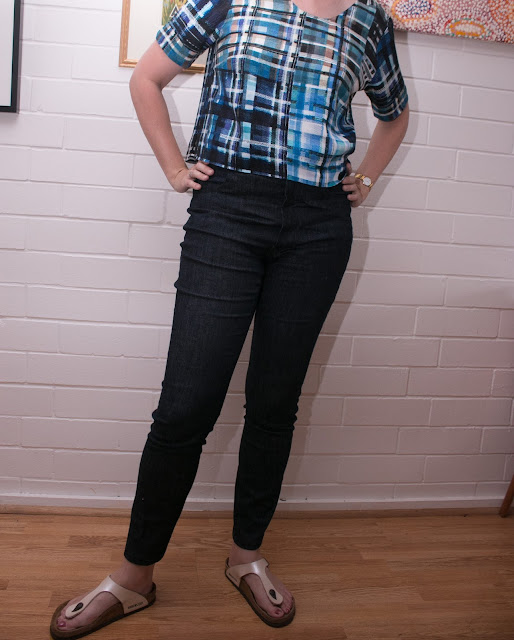The jacket project

Details
Pattern: Grainline Morris Blazer
Size: 10
Fabric: 1.5 metres of Dark teal coloured twill poly rayon slub (from Textile Traders), total cost $10.79
Extras: A bit of woven interfacing at $5.59 a metre
It started
with a message from a dear friend –“thinking of attempting to sew a tailored
jacket as a winter project... Crazy?” followed by "Want to join me in crazy jacket project?".
We chose the
newly released Grainline Morris Jacket as it looked stylish and is unlined, and
didn’t have a notched collar.
I found this
unidentifiable fabric at Textile Traders during their recent 40 per cent off
sale. It’s has a slight stretch, a lovely soft texture and a beautiful drape.
I traced a
straight size 10, based on my measurements and the fit turned out perfectly.
It took me three
evenings after work to complete this jacket – one to cut it out and fuse the
interfacing and another two to sew together.
Being a poly-rayon
I wasn’t game to have the iron on too hot so it took a while, and a press cloth,
to get the interfacing stuck on. I used white interfacing, which probably wasn’t
ideal but it is all hidden in the facing and I really wanted to use the soft
woven sort. I was introduced to it by one of the staff at TT a few months ago
and it’s so much nicer than the stiff papery kind I had been using before, it
hold the drape and doesn’t bubble over time.
The fabric
didn’t really press well, and of course being part poly I didn’t want to have
it too hot, but I got there in the end.
(Textile
Traders might not have the best range of fabric but the staff are all lovely,
helpful and I often overhear them displaying superhuman levels of patience and
tact when trying to help customers who come in with very erm, ambitious sewing
project. You have to actually being a sewer to get a job there apparently, and
it shows.)
It all came
together pretty easily, I just took it slowly and tried to follow the
instructions. Essentially you make the jacket, then make the shawl collar and
back facing as one big circle and then bring them together, then top stitch the
whole way round.
I got stuck
on step 15 though, which just made no sense, and it wasn’t really something I
could just figure out either. Fortunately I remembered ready on Sew Busy Lizzy
that she had run into trouble, and went back and looked at her blog and figured
it out.
She’s
written out her
version of step 15, which untangles some of the confusion about where to line
up the facing pieces and unfolding the fold line.
(am I the only person who constantly tries things on as I go, to reassure myself there is an actual wearable garment forming, then texts the photos to people?)
The only
thing I would change if doing this again would be to try out my topstitches on
a pieces of scrap first, and possible make them a bit longer, to make less of
an imprint on a spongy stretch.
I would also
try to think of a way of modifying the top stitching pattern on the front
points of the jacket, as the arrangement, having you top stitch the front 6mm
from the front edge then come in and going along the facing an inch in creates
a slightly bubbly effect and stop the point looking completely smooth. I’ve
seen this on other versions online as well and I think I’d look for a way of
making it less stark.
Not sure if
that makes sense, but here’s a picture of the bit I’m talking about.
(Something REALY WEIRD happened to the colour in the camera when I took these shots. I corrected most of them but this last one came out grey.)
Overall
though, I LOVE this jacket. It’s as soft and comfortable as a cardigan but
looks smart like a jacket. The three-quarter sleeves and cropped length of the
blazer work well over t-shirts (I wore it here with a newly-made, yet to be
blogged Scout)
and I actually got compliments on it from people at work who didn’t know I had
made it.
It’s one of
the first things I have made that I have felt completely satisfied with and it’s
already been worn a lot. I’m not on the lookout for fabric to make another one.







Comments
Post a Comment